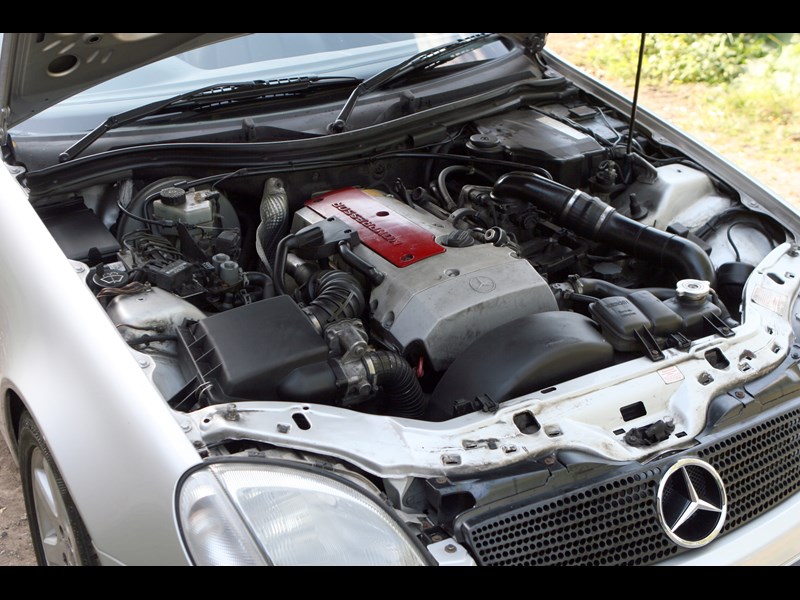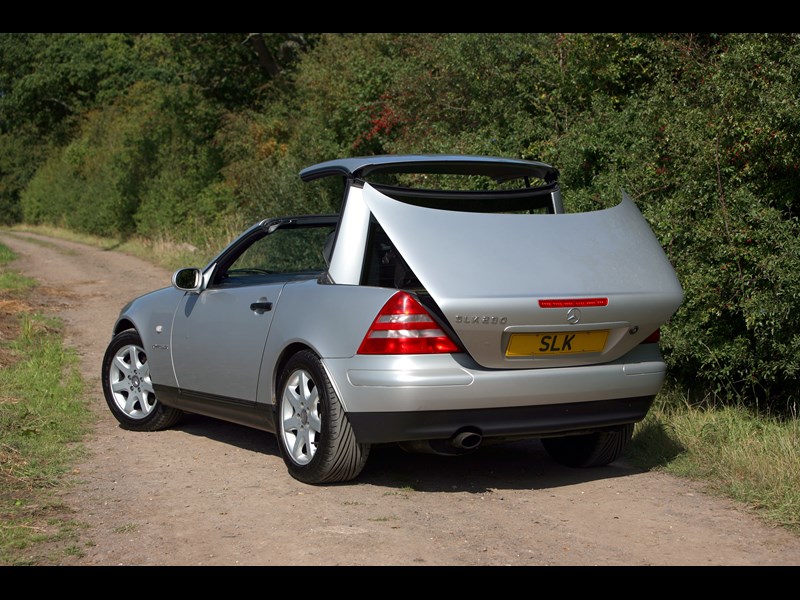Can’t decide whether you want a coupé or a cabriolet? With a Mercedes SLK you can have the best of both worlds.
Way back in 1934, Peugeot introduced the world’s first coupé-cabriolet, the 401 Eclipse. But it would be another 60 years before the configuration would be made popular, by Mercedes with its SLK. Unveiled as a concept at the 1994 Turin salon, it wouldn’t be until November 1996 that the production car would arrive in the UK.
At first there was only a 193bhp SLK 230K, and things would stay that way until February 2000 when the SLK 200Kand SLK 320 joined the range, offering 163bhp and 218bhp respectively. It was the SLK 32 AMG of August 2001 that really put some zest into the range though, with its 354bhp supercharged V6.
In July 2004 the second-generation SLK reached showrooms, but not before Mercedes had unleashed a couple of limited-run models with some of the least imaginative names ever. In June 2002 we got the Limited Edition, with 7.5x17 alloys, black nappa leather and brushed aluminium interior trim. This was followed up by the Special Edition in January 2004, with 16" alloys, grey or red nappa leather and brushed alloy interior detailing.
By far the majority of SLKs have just four (supercharged) cylinders, and as a result there’s a decent balance of fuel economy and performance. But the SLK320, with its 3.2-litre V6, is worth seeking out as it sounds so much more muscular and offers significantly more low-down torque without too much of a fuel consumption penalty.
Whichever variation on the theme you go for you get anti-lock brakes with discs all round for ample stopping power, and a surprisingly comfortable ride considering the SLK’s relatively small proportions. Combine tin-top security and refinement when the roof is up, with the fun driving experience you get only with a proper convertible, and the SLK offers the best of all worlds for MG Midget money.
VITAL STATISTICS
SLK230K auto
Engine 2295cc/4-cyl/OHC
Power (bhp@rpm) 193@5300
Torque (lb ft@rpm) 206@2500
Top speed 142mph
0-60mph 7.3sec
Consumption 32mpg
Gearbox 6-sp man/5-sp auto
Weights and measures
Height 157.5in (4.00m)
Width 68in (1.72m)
Length 51in (1.29m)
Wheelbase 94.5in (2.40m)
Kerbweight 2750lb (1250kg)
WHAT TO LOOK FOR
Corrosion can be a real issue, so check the suspension arms and brake pipes for rust. If these have corroded there will be much worse hidden away. Check the wheelarches, sills, boot lid and number plate surrounds, the area around the rear number plate light, as well as the fuel filler flap. Also inspect the leading edge of the bonnet; the paint chips and corrosion then sets in. Analyse the whole front end for poorly touched in stone chips; you might have to budget for a front-end respray. The front wings can also rust; it’s most likely around the wheelarch lips as well as along the lower edge, where it butts up to the wraparound bumper. Finish by looking where the two halves of the roof meet; corrosion can set in on both parts.
Four-cylinder engines are robust but supercharger bearings can fail, leading to rattling on tickover. The blower will continue to work but it’ll get noisy; reconditioned superchargers cost around £500. The V6 is also tough but air mass sensors fail; new ones cost £85.
Some cars have a manual gearbox, but most UK SLKs got a five-speed auto that’s lively and shifts ratios smoothly. If the car has a six-speed manual gearbox, make sure the changes are slick; this transmission can fail, although occurrences are rare. Manual gearboxes have a following but buyers tend to prefer autos; the SLK32 AMG came in auto form only.
The charging system can fail when the voltage regulator on the alternator packs up. Also take a look at the front fog lights; these can mist up then corrode internally, so make sure there’s no rust evident. The headlights are incredibly poor on dipped beam, although they’re fine on main beam. The solution is to fit stronger, aftermarket bulbs. Other likely electrical glitches include the heater resistor (easily and cheaply replaced), the air conditioning condensor and compressor (it can cost over £1000 to replace both), the boot lights and the brake light switches. The rear light circuit boards can melt (they’re repairable though) and the alarm horn can sound continuously once water has got into it – many owners just disconnect it.
Catalytic converters can pack in, which is why you should have an emissions check performed before buying, because replacement converters are very costly. There are three of them and if they all need to be replaced, which is unlikely, the bill will easily come to over £1000.
The roof mechanism is complicated but it should also prove reliable. However, there are various sensors which can play up if the car isn’t used regularly, so put the roof up and down a few times to make sure all is well. The hydraulic oil should also be replaced every 10 years or so, and it’s worth swapping the pump relay (under a cover on the right-hand side of the boot) as a matter of course periodically, as they fail. They’re £12 apiece and take a couple of minutes to swap over.
Check the seats for signs of wear, especially the driver’s seat bolsters. Check behind the seats for evidence of water getting in; the seals for the rear quarterlights can fail, and because they’re very costly they’re sometimes just left to leak – which only increases the bill, ultimately. The door check strap can also fail; new ones aren’t expensive.
The factory-supplied wheels will probably be looking tatty by now, unless they’ve already been refurbished or the car has been really cherished. Corrosion and peeling lacquer is par for the course, but getting them revived is easy enough. Expect to pay anywhere between £50 and £100 per wheel, depending on who does the work and what finish you want. Be wary of aftermarket wheels as some are poorly made and many don’t suit the car’s understated looks.
OUR VERDICT
Mercedes ramped up production of its cars in the 1990s, so there are plenty of SLKs to go round. You won’t have to dig deep to buy one either, but you will have to check carefully before buying. While the SLK is superbly engineered, build quality isn’t always what you might expect of the three-pointed star.














